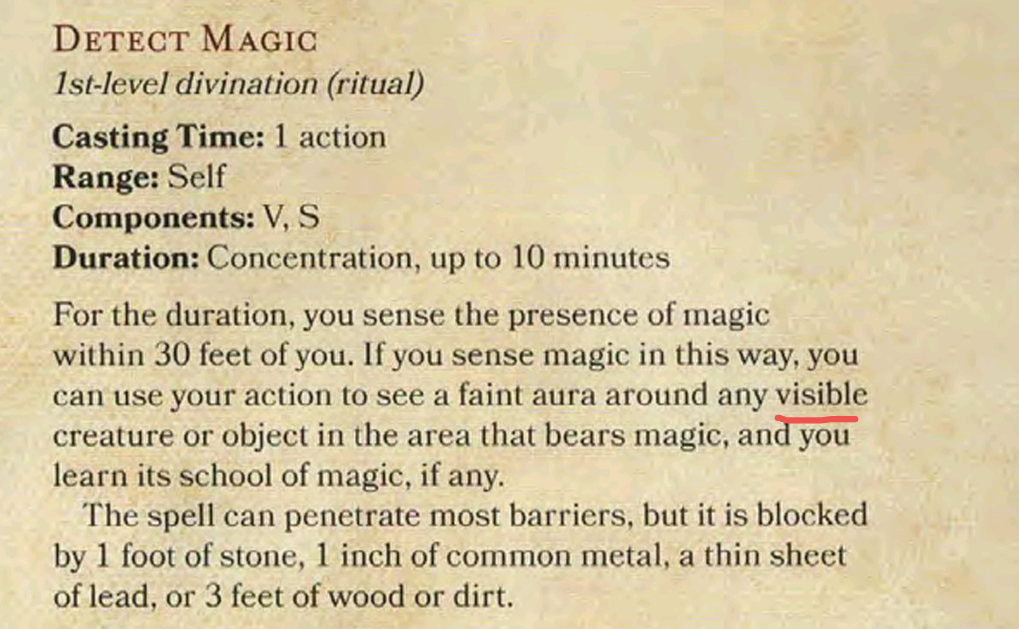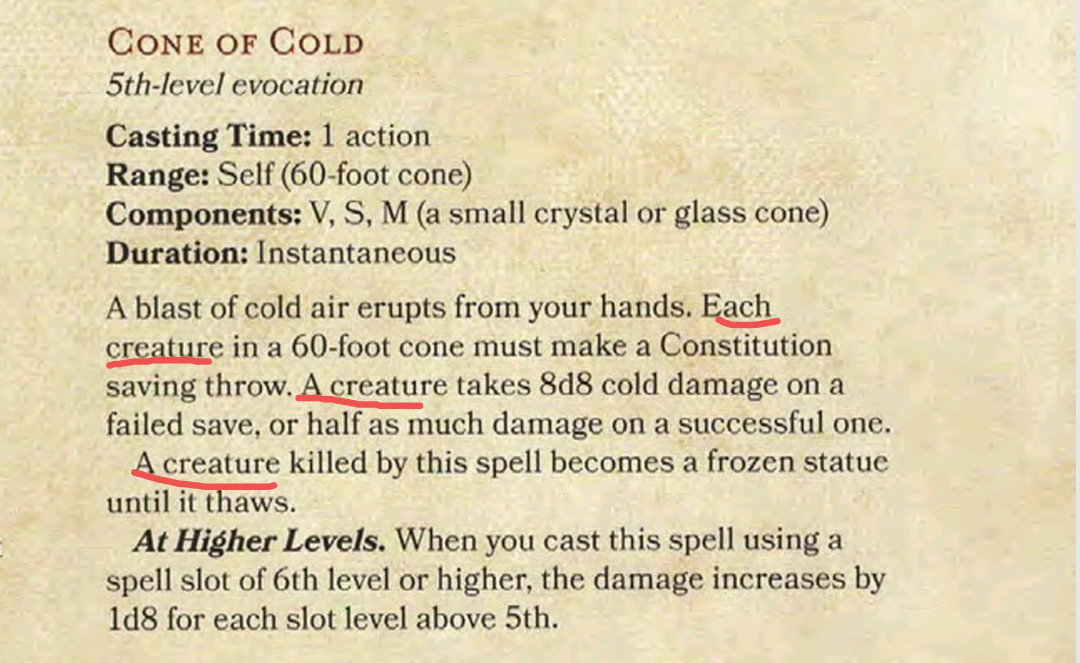This definetly seem very intentional…
-
If you can target an invisible wall, it introduces a lot of ways for things to go wrong. The spell caster is taking elements on faith and making assumptions, and those can be subverted…
-
This post did not contain any content.
I would go line of fire logic.
You theoretically can not target the wall, but you can target something on the outerside and will then hit the wall instead
-
Technically it only refers to visible creatures. Objects doesnt have the adjective visible.
Unlikely, but a particularly bull headed person could read this as though detect magic could identify invisible objects.
I’m kinda surprised how vague many of the DnD rules are written.
Didn’t they have a rules lawyer at hand when writing these?
-
I would go line of fire logic.
You theoretically can not target the wall, but you can target something on the outerside and will then hit the wall instead
As I have said in another comment, that is RAW not what would happen:
“You can’t even cast it on something behind the wall, because you cannot target something (or someone) with a spell if they are behind total cover. Total cover is created by being behind completely behind an obstacle (like a wall). This counts even if the obstacle is invisible.”
Furthermore, because if you chose an invalid target for a spell, you’d still expend the spellslot but there would be no effect. So you actually spend a sixth level spell a lot to achieve nothing."
It’s very much not RAI I’d say and I would likely handle exactly like you described, but the RAW was so wonky that I wanted to make the meme when I found out about it.
-
Yeah I thought of that one as well. It’s one of those weird cases of imprecise wording.
-
I’ve never liked arbitrary spell targeting restrictions. I say if you want to fire blindly around cover or into a fog cloud you should be able to. It doesn’t come up very often and because it’s easy for players to understand that they’ll have a very high chance of missing and losing the spell slot.
I actually think it’s a fair restriction for spells that require sight. It imposes a somewhat interesting limit on casters, especially since a lot of spells still do something on a miss.
-
Funnily enough, Shatter actually has a very easy solution: Objects just take the damage and that’s it.
-
I’d argue you can ‘see’ the wall if you place something on it, like:
- your hand
- your frontline’s hand (or some other body part)
- a ghost’s hand
- flour, dust, tar, enemies’ blood, coughing syrup, and other things that could stick to the surface
- gecko, spider, and other creatures that wouldn’t fall off; probably also your familiar; dhampir and a high level monk should work, too
I’d argue that RAW the wall is still invisible. You now just have the means to pinpoint it’s location.
-
Nope

Oh dear I didn’t even know that. Well that makes it even more absurd.
-
And this is why my group is ok saying “that rule is profoundly dumb” and ignoring it while suspecting Crawford of being involved.
Ironically here, Crawford actually thinks that the text of disintegrate does in fact permit you to target a wall of force that you can’t see. I don’t quite understand how he thinks it says that, but it does at least confirm the intention
-
And this is why my group is ok saying “that rule is profoundly dumb” and ignoring it while suspecting Crawford of being involved.
That one has nothing to do with Crawford far as I’m aware. It’s just plain stupid interaction of several rules. You are definitely intended to be able to just cast disintegrate on the wall.
Some rules are intended in a certain way and just handled poorly. The above case is (I personally think) one of them. Others are actually intended to work a certain way because of designing aspects (like verbal components having to be said at a normal volume) but people simply decide to ditch them anyway, because they like something else better. Both are valid, but they are different.
-
Funnily enough, Shatter actually has a very easy solution: Objects just take the damage and that’s it.
The ever-reliable bardic frag grenade
-
I’d argue you can ‘see’ the wall if you place something on it, like:
- your hand
- your frontline’s hand (or some other body part)
- a ghost’s hand
- flour, dust, tar, enemies’ blood, coughing syrup, and other things that could stick to the surface
- gecko, spider, and other creatures that wouldn’t fall off; probably also your familiar; dhampir and a high level monk should work, too
Or just interpret it as line of sight.
-
I don’t get it. Can you explain?
Edit (literally 10 seconds after submitting my comment): is the problem that a literal reading of this would suggest that even if more than one creature is caught in the cone, only one takes the damage?
On a tangenty note, this is one of the reasons I find board games and TTRPGs super fun: DnD 5e has a lot of these kinds of problems (which is why there’s so many sage advice clarifications), but even in more precisely written games, the interplay between Rules as Written (RAW) and Rules as Intended (RAI) is super interesting, because we have no direct way of accessing RAI. Even when the games designers chip in with clarifications, as with Sage Advice, all that does is give us more RAW to interpret. All we can do is guess at the RAI, which sometimes means actively ignoring the RAW.
It’s also cool to see how that tension manifests from the game design angle. I have a couple of friends who have either made board games, or written TTRPG books. Whether you’re the reader or the writer, the one constant is that words are slippery and unreliable, so there will always be a gap between RAW and RAI
-
This post did not contain any content.
This is a supremely silly thread and I am enjoying it greatly. Thanks for catalysing these cool discussions OP.
-
I don’t get it. Can you explain?
Edit (literally 10 seconds after submitting my comment): is the problem that a literal reading of this would suggest that even if more than one creature is caught in the cone, only one takes the damage?
On a tangenty note, this is one of the reasons I find board games and TTRPGs super fun: DnD 5e has a lot of these kinds of problems (which is why there’s so many sage advice clarifications), but even in more precisely written games, the interplay between Rules as Written (RAW) and Rules as Intended (RAI) is super interesting, because we have no direct way of accessing RAI. Even when the games designers chip in with clarifications, as with Sage Advice, all that does is give us more RAW to interpret. All we can do is guess at the RAI, which sometimes means actively ignoring the RAW.
It’s also cool to see how that tension manifests from the game design angle. I have a couple of friends who have either made board games, or written TTRPG books. Whether you’re the reader or the writer, the one constant is that words are slippery and unreliable, so there will always be a gap between RAW and RAI
The problem is that the RAW implies only things considered creatures caught in the area take damage.
That would also mean Fireball only does damage to creatures, and everything else is just ignited and only if they’re flammable? Worst game ever.
Edit: Wait a minute. Player Handbook, Chapter 8
Characters can also damage objects with their weapons and spells. Objects are immune to poison and psychic damage, but otherwise they can be affected by physical and magical attacks much like creatures can.
Am I missing something here? Why isn’t Prismatic Wall affected? Are walls not objects?
DMG, page 246 mentions walls specifically:
Use common sense when determining a character’s success at damaging an object. Can a fighter cut through a section of a stone wall with a sword? No, the sword is likely to break before the wall does.
Common sense, my worst nemesis

-
Rulings like this annoy me. Like, if he had said “the spell is poorly written, because our intention is that a wall of force can be targeted by disintegrate, but you’re right that that’s not what the spell descriptions say”, then I’d be able to respect that a lot more than what you describe him saying.
Words are a slippery beast, and there will always be a gap between Rules as Intended and Rules as Written. Good game design can reduce that gap, but not if the designers aren’t willing to acknowledge the chasm they have created
-
Crawford also rules that See Invisibility doesn’t remove the advantage/disadvantage on attack rolls because it doesn’t say so in the spell’s effect, so… Yeah, I always ignore what he says.
What? That’s so silly.
-
By that logic you can see air because there’s clouds in the sky.
There’s also blue in the sky. That’s literally you seeing the air
-
There’s also blue in the sky. That’s literally you seeing the air
Actually that’s us seeing light.
Edit: specifically, the light wavelength that remains at passing through the atmosphere. We’re but seeing the air still, we’re just seeing the color that makes it through to us. Saying that’s the air itself would be like saying you see the cities filtration system by looking at the clean water that comes from a faucet.
A better example of actually seeing air would be to freeze it, and seeing the literal frozen air.

